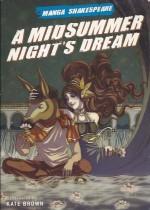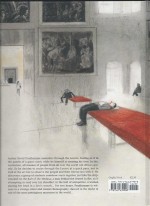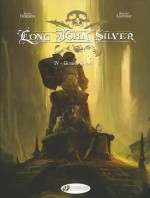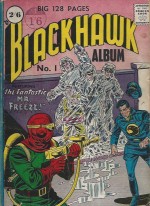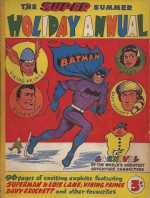
By Goscinny & Tabary, translated by Jerome Saincantin (Cinebook)
ISBN: 978-1-84918-260-7
For the greater part of his far-too-short lifetime René Goscinny (1926-1977) was one of the world’s most prolific and widely-read writers of comic strips.
He still is.
Amongst his most popular and enduring comic collaborations are Lucky Luke, Le Petit Nicolas, Signor Spaghetti and, of course, Asterix the Gaul, but there were so many others, such as the despicably dark deeds of a dastardly usurper whose dreams of diabolical domination perpetually proved to be ultimately no more than castles in the sand…
In the rueful aftermath of the Suez crisis, the French returned Рby way of comics, at least Рto the hotly contested Arabian deserts as Goscinny teamed with hugely gifted Swedish ̩migr̩ Jean Tabary (1930-2011) Рwho numbered Richard et Charlie, Grabadu et Gabaliouchtou, Totoche, Corinne et Jeannot and Valentin le Vagabond amongst his other hit strips Рto deliriously detail the innocuous history of imbecilic Arabian (im)potentate Haroun el-Poussah.
However, as is so often the case, it was the strip’s villainous foil – power-hungry vizier Iznogoud – who stole the show… possibly the conniving little blackguard’s only successful coup.
The first kernel of inspiration came as a piece of background shtick in early 1960s kids’ cartoon book Les Vacances du Petit Nicholas (which we all saw as Nicholas on Holiday). A fuller formation and development came with Les Aventures du Calife Haroun el Poussah, created for Record: debuting in the January 15th issue of 1962.
A petite hit, the feature subsequently jumped ship to Pilote – a new comic created and edited by Goscinny – where it was artfully refashioned into a starring vehicle for the unpleasant little upstart who had been hogging all the laughs and limelight.
The Vile Vizier went from strength to strength. According to the brief introduction in this volume, the unwieldy catchphrase “I want to be Caliph instead of the Caliph!†quickly became part of casual French idiom and, in October 1974, the wee rascal won his own socio-political commentary column in newspaper Journal du Dimanche.
Insidious Iznogoud is Grand Vizier to Haroun Al Plassid, the affable, easy-going Caliph of Ancient Baghdad, but the sneaky little second-in-command has loftier ambitions, or as he is always declaiming “I want to be…â€
The retooled rapscallion resurfaced in Pilote in 1968, quickly becoming a massive hit, resulting in 29 albums to date (17 by dream team Goscinny & Tabary), his own solo comic, a computer game, animated film, TV cartoon show and even a live-action movie.
Like all great storytelling, Iznogoud works on two levels: for youngsters it’s a comedic romp with adorably wicked baddies invariably hoisted on their own petards and coming a-cropper, whilst older, wiser heads can revel in pun-filled, witty satires and superbly surreal antics.
Following Goscinny’s death in 1977, Tabary began scripting tales, switching to book-length complete adventures rather than the short, snappy vignettes which typified his collaborations. Upon his own passing, Tabary’s children Stéphane, Muriel and Nicolas took over the franchise.
The deliciously malicious whimsy is resplendent in its manic absurdity, cleverly contemporary cultural critiques, brilliantly delivered creative anachronisms and fourth-wall busting outrages which serve to keep the assorted escapades bizarrely fresh and hilariously inventive.
Le conte de fée d’Iznogoud (Iznogoud’s Fairy Tale) was originally released in 1976; wracking up an even dozen deliciously daft album compilations, and proffering a potent remarkable quartet of trend-setting tales with our ambitious autocrat as ever scheming to seize power from his good but gullible Lord and Master.
Following the aforementioned Introduction and a preface page reintroducing our constant cast, the merry madness kicks off with ‘Fairy Tale’ as extremely inept Fairy Godmother Blunderbell – in search of an impoverished princess to assist – lands instead in the truculent toad’s lap.
Once she’s convinced him that even if her spells don’t go exactly to plan, the recipient of her magic experiences astounding transformations, it’s not long before she’s gulled into making him the Caliph instead of the Caliph.
…At least that was the plan: have we mentioned that Blunderbell’s not the most accurate spell-caster in the world?
Mystic mayhem also abounds in ‘Mirror Image’ as, on the eve of the ten-yearly vote to reaffirm the Caliph as supreme ruler, Iznogoud is accosted by Al Hiss the Genie from the other side of his looking glass. The fantastic land is completely the same as but exactly reversed from home, and Iznogoud’s shenanigans actually succeed in fixing this election. However although the little schemer actually ousts the Caliph, he has forgotten one crucial factor…
Newly arrive tradesman Tremolo has a strong line in enchanted furnishings. After an astonishingly annoying bout of window shopping the Vizier and his foolish flunky Wa’at Alahf take possession of a fearsomely final divan of despatch dubbed ‘The Send-Away Bed’…
Whoever lies in it vanishes forever, but thanks to visiting dignitaries and the world’s worst case of coffee-nerves, the machinations needed to get the normally sleep-loving Caliph to try it out are doomed to failure… as is Iznogoud…
All the rules and much of the internal logic are thrown away for the closing, epic length saga of ‘The Magic Minarets’ as the strips disgruntled fans rise up in revolt, demanding a proper resolution to the Vizier’s schemes.
What they actually get is a madcap metaphysical odyssey as Iznogoud is sucked into a fantastic realm where he must competitively quest for ten wizardly ideals whilst his moral fibre is tested. The prize for success is the granting of his greatest desire…
However, even after cheating his way to victory, fate has a way of upsetting his game…
Such convoluted witty, fast-paced hi-jinks and craftily crafted comedy set pieces have made this addictive series a household name in France where “Iznogoud†is also common parlance for a certain kind of politician: over-ambitious, unscrupulous – and frequently insufficient in inches (or should that be centimetres?).
Desiring to become “Caliph in the Caliph’s place†is a popular condemnation in French, targeting those perceived as overly-ambitious, and, since 1992 the Prix Iznogoud is awarded annually to “a personality who failed to take the Caliph’s placeâ€.
Nominees are chosen from prominent French figures who have endured spectacular defeats in any one year and been given to the likes of Édouard Balladur (1995) and Nicolas Sarkozy (1999). The jury panel is headed by politician André Santini, who gave himself one after failing to become president of Île-de-France in regional elections in 2004.
When first released in Britain during the late 1970s and 1980s (and latterly in 1996 as a periodical comicbook) these tales made little impression on British audiences, but at last this wonderfully beguiling strip has deservedly found an appreciative audience among today’s more internationally aware, politically jaded comics-and-cartoon savvy connoisseurs…
Original edition © 2012 IMAV éditions by Goscinny & Tabary. All rights reserved. English translation © 2015 Cinebook Ltd.

